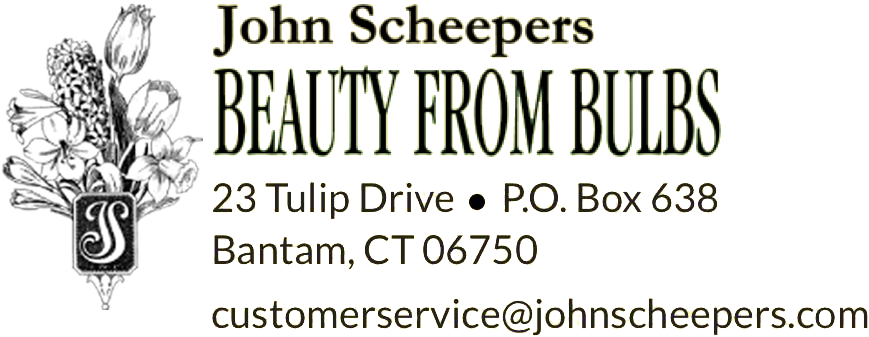 The best type of soil for flower bulbs is a sandy loam. It can be described as a balanced mixture of clay, sand, silt and a modicum of organic matter. Sandy loam usually is around neutral pH and affords good water drainage, root permeability and adequate nutrition. All flower bulbs require neutral pH soil (7.0) in order to grow roots. Less than 7.0 pH is acidic. Higher than 7.0 pH is alkaline. Acidic or alkaline soil prevents bulb root growth. Flower bulb planting sites (woodlands, display gardens or lawns) should be amended to neutral pH so that the bulbs may develop mature root systems. For detailed information on how to correct pH levels, one should contact a good local nursery or garden center.
The best type of soil for flower bulbs is a sandy loam. It can be described as a balanced mixture of clay, sand, silt and a modicum of organic matter. Sandy loam usually is around neutral pH and affords good water drainage, root permeability and adequate nutrition. All flower bulbs require neutral pH soil (7.0) in order to grow roots. Less than 7.0 pH is acidic. Higher than 7.0 pH is alkaline. Acidic or alkaline soil prevents bulb root growth. Flower bulb planting sites (woodlands, display gardens or lawns) should be amended to neutral pH so that the bulbs may develop mature root systems. For detailed information on how to correct pH levels, one should contact a good local nursery or garden center.
Clay soil is dense and heavy, rich in nutrients, moisture sodden in the winter and hard and dry in the summer. Clay soil impedes root growth and has poor, uneven and damaging water retention and drainage. Clay planting sites should be amended with sand, peat moss, neutral pH organic matter and/or neutral pH, well-aged leaf compost at least one foot beneath the bulb planting depth so that bulbs never sit in water. One should never amend individual planting holes since it would be like carving cups that could fill with water and rot the bulbs.
Sandy soils are light and dry, prone to heat retention, nutrient-poor and acidic. Silt soils are light but easily compacted, moisture-retentive and fertile. Peat soils are too high in organic matter and extremely moisture-retentive. Chalky soils are alkaline and are usually too light and nutrient-poor.
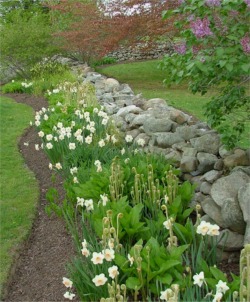 For further information about soil types, refer to the Royal Horticultural Society.
For further information about soil types, refer to the Royal Horticultural Society.
Here, we have excerpted their fine information on soil types for your reference.
The Different Soil Types
"Soils vary enormously in characteristics, but the size of the particles that make up a soil defines its gardening characteristics:
*Clay: less than 0.002mm
*Silt: 0.002-0.05mm
*Sand: 0.05-2mm
*Stones: bigger than 2mm in size
*Chalky soils also contain calcium carbonate or lime.
The dominating particle size gives soil its characteristics and because the tiny clay particles have a huge surface area for a given volume of clay they dominate the other particles:
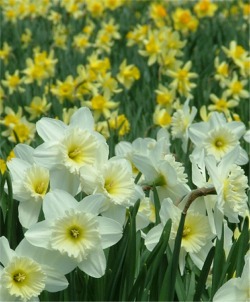 Clay soils have over 25 percent clay. Also known as heavy soils, these are potentially fertile as they hold nutrients bound to the clay minerals in the soil. But they also hold a high proportion of water due to the capillary attraction of the tiny spaces between the numerous clay particles. They drain slowly and take longer to warm up in spring than sandy soils. Clay soils are easily compacted when trodden on while wet and they bake hard in summer, often cracking noticeably. These soils often test the gardener to the limits, but when managed properly with cultivation and plant choice, can be very rewarding to work with.
Clay soils have over 25 percent clay. Also known as heavy soils, these are potentially fertile as they hold nutrients bound to the clay minerals in the soil. But they also hold a high proportion of water due to the capillary attraction of the tiny spaces between the numerous clay particles. They drain slowly and take longer to warm up in spring than sandy soils. Clay soils are easily compacted when trodden on while wet and they bake hard in summer, often cracking noticeably. These soils often test the gardener to the limits, but when managed properly with cultivation and plant choice, can be very rewarding to work with.
Sandy soils have high proportion of sand and little clay. Also known as light soils, these soils drain quickly after rain or watering, are easy to cultivate and work. They warm up more quickly in spring than clay soils. But on the downside, they dry out quickly and are low in plant nutrients, which are quickly washed out by rain. Sandy soils are often very acidic Silt soils, comprised mainly of intermediate sized particles, are fertile, fairly well drained and hold more moisture than sandy soils, but are easily compacted.
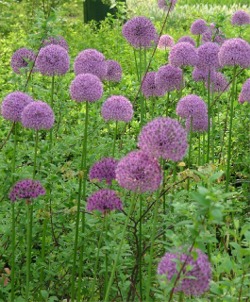 Loams are comprised of a mixture of clay, sand and silt that avoid the extremes of clay or sandy soils and are fertile, well-drained and easily worked. They can be clay-loam or sandy-loam depending on their predominant composition and cultivation characteristics.
Loams are comprised of a mixture of clay, sand and silt that avoid the extremes of clay or sandy soils and are fertile, well-drained and easily worked. They can be clay-loam or sandy-loam depending on their predominant composition and cultivation characteristics.
Peat soils are mainly organic matter and are usually very fertile and hold much moisture. They are seldom found in gardens.
Chalky or lime-rich soils may be light or heavy but are largely made up of calcium carbonate and are very alkaline.
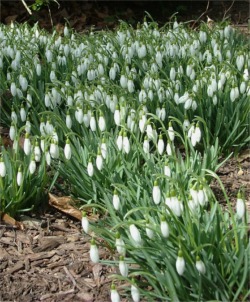 Where building or landscaping has mixed up different soils, it can be very difficult to tell what type of soil you have, and it may change markedly over a short distance."
Where building or landscaping has mixed up different soils, it can be very difficult to tell what type of soil you have, and it may change markedly over a short distance."
Identifying your Soil Type
The best way to tell what type of soil you have is by touching it and rolling it in your hands.
Sandy soil has a gritty element~you can feel sand grains within it, and it falls through your fingers. It cannot be rolled to make a sausage shape. If it is not a coarse sand and perhaps a sandy loam it may stick together better
Clay soil has a smearing quality, and is sticky when wet. It is easily rolled into a long thin sausage and can be smoothed to a shiny finish by rubbing with a finger. If is it not a heavy clay it won't get quite as shiny and be as easy to make a sausage.
Pure silt soils are rare, especially in gardens. They have a slightly soapy, slippery texture, and do not clump easily If soil froths when placed in a jar of vinegar, then it contains free calcium carbonate (chalk) or limestone and is lime rich.
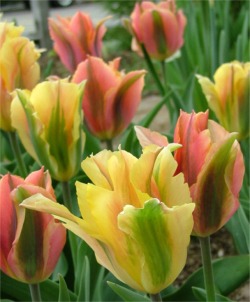 Another important aspect of soil type, is the pH (acidity or alkalinity). This will also affect the type of plants you can grow and how you manage your soil.
Another important aspect of soil type, is the pH (acidity or alkalinity). This will also affect the type of plants you can grow and how you manage your soil.
Working with your Soil
Now you know what type of soil you have, you can start to work with it and improve it.
Clay Soils
Clay soils are rich in nutrients and very fertile if their cloddiness can be broken up by the addition of organic matter. This breaks down the clay into separate crumbs, making the water and nutrients held within the clay more easily available to plant roots. Breaking up the clay into crumbs also makes the soil warmer, more easily workable and less prone to compaction.
Sandy Soils
These light soils are usually low in nutrients, and lose water very quickly being particularly free-draining. You can boost the water and nutrient holding capacity of your soil by adding plenty of organic matter to bind the loose sand into more fertile crumbs. Fertilizers may also be necessary to give plants grown in sandy soils an extra boost.
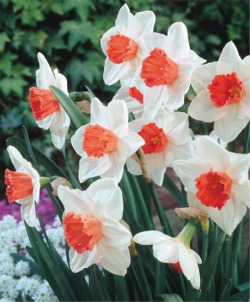 Silt Soils
Silt Soils
These soils are made up of fine particles that can be easily compacted by treading and use of garden machinery. They are prone to washing away and wind erosion if left exposed to the elements without plant cover. However, they contain more nutrients than sandy soils and hold more water, so tend to be quite fertile. You can bind the silt particles into more stable crumbs by the addition of organic matter.
Loams
These soils are the gardener's best friend, being a 'perfect' balance of all soil particle types. But even though they are very good soils, it is important to regularly add organic matter, especially if you are digging or cultivating these soils every year.
Chalky Soils
Chalky soils are alkaline, so will not support ericaceous plants that need acid soil conditions. Very chalky soils may contain lumps of visible chalky white stone. Such soils cannot be acidified, and it is better to choose plants that will thrive in alkaline conditions. Many chalky soils are shallow, free-draining and low in fertility, but variations exist, and where there is clay present, nutrient levels may be higher and the water holding capacity greater.
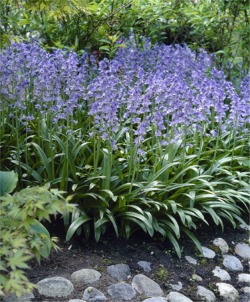 Problems
Problems
Certain soil types are prone to particular problems. Clay soils can suffer drainage problems and may not suit plants that need free draining conditions. Light, sandy soils need a lot of watering."
Sincere thanks to the Royal Horticultural Society.
Never Use Acidic or Alkaline Soil Amendments
Flower bulbs must be planted in neutral pH soil.
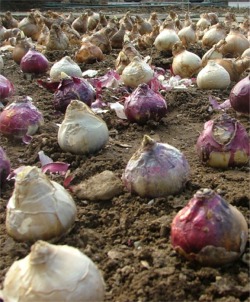 Never amend soil with or use top dressings of mint mulch, horse manure, chicken droppings, mushroom compost, other "hot" manure, garden compost, household compost or commercial soil amendments for flower bulb planting holes or beds. They are not neutral pH. These top dressings or soil additives create acidic or alkaline pH levels that prevent or retard root growth, mummify bulbs. To the extreme, they can actually rot the bulbs themselves. Immature root growth results in stunted plant growth, paltry foliage and few, if any flowers, or no plant growth.
Never amend soil with or use top dressings of mint mulch, horse manure, chicken droppings, mushroom compost, other "hot" manure, garden compost, household compost or commercial soil amendments for flower bulb planting holes or beds. They are not neutral pH. These top dressings or soil additives create acidic or alkaline pH levels that prevent or retard root growth, mummify bulbs. To the extreme, they can actually rot the bulbs themselves. Immature root growth results in stunted plant growth, paltry foliage and few, if any flowers, or no plant growth.
Garden and household compost often fail to decompose fully due to insufficient heat generation, and can be a breeding ground for damaging fungus and weeds.
In a nutshell, what is good for tomatoes or roses is not necessarily good for flower bulbs. If one has to do any sort of soil composition work, it is best to do so for the entire planting site or bed, never in individual bulb planting holes. We recommend that nothing ever be placed in the bottom of each planting hole to avoid even the slightest possibility of root burn.



